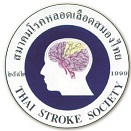The Incidence of Post Stroke Pneumonia and the Use of Modified Water Swallowing Test in Acute Stroke Patients
คำสำคัญ:
dysphagia screening, modified water swallowing test, post stroke pneumoniaบทคัดย่อ
Background and Objective: Dysphagia is a common problem after stroke which may lead stroke patients to have a potential for life-threatening complications such as pneumonia. Therefore, the universal screening of swallowing function is recommended. This study aims to evaluate a result of modified water swallowing test (MWST) applied in stroke units and incidence of pneumonia after stroke.
Materials and Methods: Data were collected from the Maharat Nakhon Ratchasima stroke registry between January 1, 2017 to December 31, 2017.
Results: A total of 98 patients were enrolled, of these 64 (69.4%) patients were documented MWST and 34 (34.7%) patients were not. In the documented group, 45 (71.4%) patients met the MWST screening criteria, 25 (55.6%) patients passed and 20 (44.4%) patients failed the screening test but only 3 (5.3%) patients were referred for a rehabilitation program. Incidence of aspiration pneumonia was 73.5 % (72 of 98 patients). In a group of patients who were screened by MWST, pneumonia was found in 85% (17 of 20 patients) of patients with MWST score 1-4 (failed) and 60% (15 of 25 patients) with MWST score 5 (passed).
Conclusion: Most stroke patients have dysphagia screening but only a few patients who failed screening were referred for swallowing rehabilitation program. The further expansion of the screening strategies, and management is necessary to reduce post stroke pneumonia.
เอกสารอ้างอิง
2. Suwanwela NC. Stroke epidemiology in Thailand. Journal of stroke. 2014;16(1):1-7.
3. Heuschmann PU, Kolominsky-Rabas PL, Misselwitz B, Hermanek P, Leffmann C, Janzen RW, et al. Predictors of in-hospital mortality and attributable risks of death after ischemic stroke: the German Stroke Registers Study Group. Archives of internal medicine. 2004;164(16):1761-8.
4. Sellars C, Bowie L, Bagg J, Sweeney MP, Miller H, Tilston J, et al. Risk factors for chest infection in acute stroke: a prospective cohort study. Stroke. 2007;38(8):2284-91.
5. ชัยวิวัฒน์ ตุงคะเสรีรักษ์, พาวุฒิ เมฆวิชัย, ลำพู จันทร์กลาง, สุรินทร์ แซ่ตัง. อุบัติการณ์และปัจจัยที่ เกี่ยวข้องของการเกิดภาวะปอดอักเสบภายหลังโรค หลอดเลอืดสมองเฉยีบพลนั ในประเทศไทย. วารสาร ประสาทวิทยาแห่งประเทศไทย. 2558;31(1):13-20.
6. Joundi RA, Martino R, Saposnik G, Giannakeas V, Fang J, Kapral MK. Predictors and Outcomes of Dysphagia Screening After Acute Ischemic Stroke. Stroke. 2017;48(4):900-6.
7. Seo HG, Kim JG, Nam HS, Lee WH, Han TR, Oh BM. Swallowing Function and Kinematics in Stroke Patients with Tracheostomies. Dysphagia. 2017;32(3):393400.
8. Ickenstein GW, Hohlig C, Prosiegel M, Koch H, Dziewas R, Bodechtel U, et al. Prediction of outcome in neurogenic oropharyngeal dysphagia within 72 hours of acute stroke. Journal of stroke and cerebrovascular diseases : the official journal of National Stroke Association. 2012;21(7):569-76.
9. Gillman A, Winkler R, Taylor NF. Implementing the Free Water Protocol does not Result in Aspiration Pneumonia in Carefully Selected Patients with Dysphagia: A Systematic Review. Dysphagia. 2017;32(3):345-61.
10. Lim SH, Lieu PK, Phua SY, Seshadri R, Venketasubramanian N, Lee SH, et al. Accuracy of bedside clinical methods compared with fiberoptic endoscopic examination of swallowing (FEES) in determining the risk of aspiration in acute stroke patients. Dysphagia. 2001;16(1):1-6.
11. Noll SF BC, Nelson MC. Rehabilitation of patients with swallowing disorders. In: Braddom RL, editor. Physical medicine and rehabilitation. Philadelphia: Saunders; 1996. p. 533-54.
12. Osawa A, Maeshima S, Tanahashi N. Water-swallowing test: screening for aspiration in stroke patients. Cerebrovascular diseases. 2013;35(3):276-81.
13. Go S, Worman DJ. Stroke Syndromes. In: Tintinalli J, Stapczynski J, Ma OJ, Cline D, Cydulka R, Meckler G, editors. Tintinalli’s Emergency Medicine: A Comprehensive Study Guide, Seventh Edition (Book and DVD): Mcgraw-hill; 2010.
14. MayoClinic. Pneumonia. [Internet]. 2018 [cited 2019 Apr 29]. Available from: https://www. mayoclinic.org/diseases-conditions/ pneumonia/symptoms-causes/syc-20354204
15. Satoshi Horiguchi YS. Screening Tests in Evaluating Swallowing Function. The journal of Japan Mecical Association. 2011;54(1):31-4.
16. Casaubon LK, Boulanger JM, Blacquiere D, Boucher S, Brown K, Goddard T, et al. Canadian Stroke Best Practice Recommendations: Hyperacute Stroke Care Guidelines, Update 2015. International journal of stroke : official journal of the International Stroke Society. 2015;10(6):924-40.
17. รัตนา นิลเพชร์พลอย. สมศักดิ์ เทียมเก่า. ทรงขวัญ ศิลารักษ์. โรคหลอดเลือดสมองชนิดขาดเลือด ในผู้ป่วยอายุน้อยในโรงพยาบาลศรีนครินทร์. ศรีนครินทร์เวชสาร 2547;19(3):122-30.
18. Marini C, Russo T, Felzani G. Incidence of stroke in young adults: a review. Stroke research and treatment. 2010;2011:1-5.
19. Smithard DG. Dysphagia management and stroke units. In: Marthin RE, editor2016. Swallowing disorder. CurrPhys Med Rehabil Rep 2016; 4:p.287-294.
20. Sivertsen J, Graverholt B, Espehaug B. Dysphagia screening after acute stroke: a quality improvement project using criteria-based clinical audit. BMC Nursing. 2017;16(1):27.
21. วิทูร ลีลามานิตย์. Anatomy and Physiology of Swallowing. ใน: กลืนลำบากและสำลัก: Dysphagia and aspiration. สงขลา: ชานเมืองการพิมพ์; 2548. หน้า 1-17.
ดาวน์โหลด
เผยแพร่แล้ว
รูปแบบการอ้างอิง
ฉบับ
ประเภทบทความ
สัญญาอนุญาต
ข้อความภายในบทความที่ตีพิมพ์ในวารสารสมาคมโรคหลอดเลือดสมองไทยเล่มนี้ ตลอดจนความรับผิดชอบด้านเนื้อหาและการตรวจร่างบทความเป็นของผู้นิพนธ์ ไม่เกี่ยวข้องกับกองบรรณาธิการแต่อย่างใด การนำเนื้อหา ข้อความหรือข้อคิดเห็นของบทความไปเผยแพร่ ต้องได้รับอนุญาตจากกองบรรณาธิการอย่างเป็นลายลักษณ์อักษร ผลงานที่ได้รับการตีพิมพ์ในวารสารเล่มนี้ถือเป็นลิขสิทธิ์ของวารสาร





